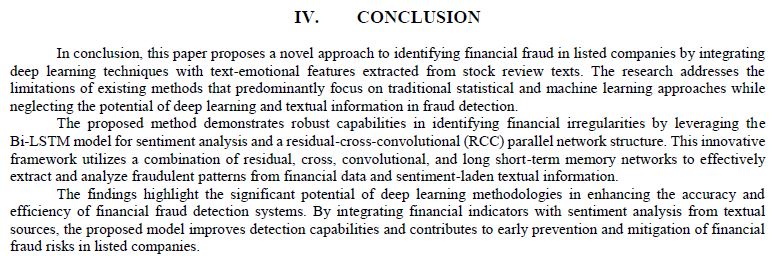Financial Fraud Detection in Listed Companies Using Deep Learning and Textual Emotion Analysis
DOI:
https://doi.org/10.5281/zenodo.12642108Keywords:
financial fraud identification, deep learning, text sentiment analysis, listed companiesAbstract
Financial fraud of listed companies refers to the bad faithless behaviour that improperly distorts accounting information, which hurts the company's management, economic development and social interests. At present, the existing research mainly focuses on financial digital data, while the exploration of text information and deep learning algorithms is relatively small. Therefore, this paper proposes a financial fraud identification method for listed companies based on deep learning and integrated text-emotional features. Firstly, the financial index is preprocessed, and then the Bi-LSTM model is used to extract the emotional features of the stock review text. Subsequently, a residual-cross-convolutional (RCC) parallel network structure is used to identify financial fraud. The network simultaneously uses a Residual network, Cross network, Convolutional network and long short-term memory network to extract the characteristics of financial fraud in a parallel way. It obtains the final recognition result through batch standardisation and a full connection layer.
Downloads
References
Yuan, J., Lin, Y., Shi, Y., Yang, T., & Li, A. (2024). Applications of artificial intelligence generative adversarial techniques in the financial sector. Academic Journal of Sociology and Management, 2(3), 59-66.
Lin, Y., Li, A., Li, H., Shi, Y., & Zhan, X. (2024). GPU-Optimized image processing and generation based on deep learning and computer vision. Journal of Artificial Intelligence General science (JAIGS), 5(1), 39-49.
Chen, Zhou, et al. (2024). Application of cloud-driven intelligent medical imaging analysis in disease detection. Journal of Theory and Practice of Engineering Science 4(05), 64-71.
Wang, B., Lei, H., Shui, Z., Chen, Z., & Yang, P. (2024). Current state of autonomous driving applications based on distributed perception and decision-making.
Zhan, X., Shi, C., Li, L., Xu, K., & Zheng, H. (2024). Aspect category sentiment analysis based on multiple attention mechanisms and pre-trained models. Applied and Computational Engineering, 71, 21-26.
Wu, B., Xu, J., Zhang, Y., Liu, B., Gong, Y., & Huang, J. (2024). Integration of computer networks and artificial neural networks for an AI-based network operator. Applied and Computational Engineering, 64, 115-120.
Liang, P., Song, B., Zhan, X., Chen, Z., & Yuan, J. (2024). Automating the training and deployment of models in MLOps by integrating systems with machine learning. Appl. Comput. Eng., 67, 1–7. Available at: https://doi.org/10.54254/2755-2721/67/20240690.
Li, A., Yang, T., Zhan, X., Shi, Y., & Li, H. (2024). Utilizing data science and AI for customer churn prediction in marketing. Journal of Theory and Practice of Engineering Science, 4(05), 72-79.
Wu, B., Gong, Y., Zheng, H., Zhang, Y., Huang, J., & Xu, J. (2024). Enterprise cloud resource optimization and management based on cloud operations. Applied and Computational Engineering, 67, 8-14.
Xu, J., Wu, B., Huang, J., Gong, Y., Zhang, Y., & Liu, B. (2024). Practical applications of advanced cloud services and generative AI systems in medical image analysis. Appl. Comput. Eng., 64, 83–88. https://doi.org/10.54254/2755-2721/64/20241361.
Zhang, Y., Liu, B., Gong, Y., Huang, J., Xu, J., & Wan, W. (2024). Application of machine learning optimization in cloud computing resource scheduling and management. Appl. Comput. Eng., 64, 17–22. https://doi.org/10.54254/2755-2721/64/20241359.
Huang, J., Zhang, Y., Xu, J., Wu, B., Liu, B., & Gong, Y. (2024). Implementation of seamless assistance with Google Assistant leveraging cloud computing. Appl. Comput. Eng., 64, 170–176. https://doi.org/10.54254/2755-2721/64/20241383.
Shi, Y., Li, L., Li, H., Li, A., & Lin, Y. (2024). Aspect-Level sentiment analysis of customer reviews based on neural multi-task learning. Journal of Theory and Practice of Engineering Science, 4(04), 1-8.
Shi, Y., Yuan, J., Yang, P., Wang, Y., & Chen, Z. (2024). Implementing intelligent predictive models for patient disease risk in cloud data warehousing. Appl. Comput. Eng., 67, 34–40. https://doi.org/10.54254/2755-2721/67/2024ma0059.
Zhan, T., Shi, C., Shi, Y., Li, H., & Lin, Y. (2024). Optimization techniques for sentiment analysis based on LLM (GPT-3). Appl. Comput. Eng., 67, 41–47. https://doi.org/10.54254/2755-2721/67/2024ma0060.
Li, Huixiang, et al. (2024). AI face recognition and processing technology based on GPU computing. Journal of Theory and Practice of Engineering Science, 4(05), 9-16.
Jiang, W., Qian, K., Fan, C., Ding, W., & Li, Z. (2024). Applications of generative AI-based financial robot advisors as investment consultants. Appl. Comput. Eng., 67, 28–33. https://doi.org/10.54254/2755-2721/67/2024ma0057.
Ding, W., Zhou, H., Tan, H., Li, Z., & Fan, C. (2024). Automated compatibility testing method for distributed software systems in cloud computing.
Haowei, Ma, et al. (2023). CRISPR/Cas-based nanobiosensors: A reinforced approach for specific and sensitive recognition of mycotoxins. Food Bioscience, 56, 103110.
Fan, C., Li, Z., Ding, W., Zhou, H., & Qian, K. (2024). Integrating artificial intelligence with SLAM technology for robotic navigation and localization in unknown environments. Appl. Comput. Eng., 67, 22–27. https://doi.org/10.54254/2755-2721/67/2024ma0056.
Guo, L., Li, Z., Qian, K., Ding, W., & Chen, Z. (2024). Bank credit risk early warning model based on machine learning decision trees. Journal of Economic Theory and Business Management, 1(3), 24-30.
Li, Zihan, et al. (2024). Robot navigation and map construction based on SLAM technology.
Fan, C., Ding, W., Qian, K., Tan, H., & Li, Z. (2024). Cueing flight object trajectory and safety prediction based on SLAM technology. Journal of Theory and Practice of Engineering Science, 4(05), 1-8.
Ding, W., Tan, H., Zhou, H., Li, Z., & Fan, C. (2024). Immediate traffic flow monitoring and management based on multimodal data in cloud computing. Appl. Comput. Eng., 71, 1–6. https://doi.org/10.54254/2755-2721/71/2024ma0052.
Bi, Shuochen, Wenqing Bao, Jue Xiao, Jiangshan Wang, & Tingting Deng. (2024). Application and practice of AI technology in quantitative investment. arXiv preprint arXiv:2404.18184(2024).
Qian, K., Fan, C., Li, Z., Zhou, H., & Ding, W. (2024). Implementation of artificial intelligence in investment decision-making in the chinese a-share market. Journal of Economic Theory and Business Management, 1(2), 36-42.
Liang, P., Song, B., Zhan, X., Chen, Z., & Yuan, J. (2024). Automating the training and deployment of models in MLOps by integrating systems with machine learning. Appl. Comput. Eng., 67, 1–7. https://doi.org/10.54254/2755-2721/67/20240690.
Haowei, M. A., et al. (2023). Employing Sisko non-Newtonian model to investigate the thermal behavior of blood flow in a stenosis artery: Effects of heat flux, different severities of stenosis, and different radii of the artery. Alexandria Engineering Journal, 68, 291-300.
Zhou, Y., Zhan, T., Wu, Y., Song, B., & Shi, C. (2024). RNA secondary structure prediction using transformer-based deep learning models. Appl. Comput. Eng., 64, 95–101. https://doi.org/10.54254/2755-2721/64/20241362.
Xiao, J., Wang, J., Bao, W., Deng, T., & Bi, S. Application progress of natural language processing technology in financial research.
Liu, B., Cai, G., Ling, Z., Qian, J., & Zhang, Q. Precise positioning and prediction system for autonomous driving based on generative artificial intelligence. (10个)
Cui, Z., Lin, L., Zong, Y., Chen, Y., & Wang, S. Precision gene editing using deep learning: A case study of the CRISPR-Cas9 Editor.
Wang, B., He, Y., Shui, Z., Xin, Q., & Lei, H. (2024). Predictive optimization of DDoS attack mitigation in distributed systems using machine learning. Applied and Computational Engineering, 64, 95-100.
He, Zheng, et al. Application of K-means clustering based on artificial intelligence in gene statistics of biological information engineering.
Song, J., Cheng, Q., Bai, X., Jiang, W., & Su, G. (2024). LSTM-based deep learning model for financial market stock price prediction. Journal of Economic Theory and Business Management, 1(2), 43-50.
Ni, C., Zhang, C., Lu, W., Wang, H., & Wu, J. (2024). Enabling intelligent decision making and optimization in enterprises through data pipelines.
Lu, W., Ni, C., Wang, H., Wu, J., & Zhang, C. (2024). Machine learning-based automatic fault diagnosis method for operating systems.

Downloads
Published
How to Cite
Issue
Section
ARK
License
Copyright (c) 2024 Neha Romanenko, Kritika Sharma, Siddharth Verma

This work is licensed under a Creative Commons Attribution 4.0 International License.
Research Articles in 'Applied Science and Biotechnology Journal for Advanced Research' are Open Access articles published under the Creative Commons CC BY License Creative Commons Attribution 4.0 International License http://creativecommons.org/licenses/by/4.0/. This license allows you to share – copy and redistribute the material in any medium or format. Adapt – remix, transform, and build upon the material for any purpose, even commercially.










